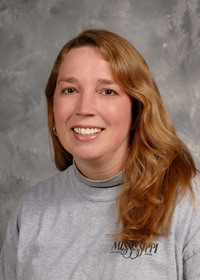Information Possibly Outdated
The information presented on this page was originally released on June 16, 2003. It may not be outdated, but please search our site for more current information. If you plan to quote or reference this information in a publication, please check with the Extension specialist or author before proceeding.
Mold poses threats to health, buildings
MISSISSIPPI STATE -- Just as smoke indicates fire, moisture indicates mold, and where there's mold, there's trouble.
Molds and mildews are forms of fungi found year-round both indoors and outdoors. They need moisture to grow, and thrive in warm, humid and damp or water-damaged conditions. Molds have odors, look bad, can cause health problems and can damage structures.
Herb Willcutt, safety specialist with the Mississippi State University Extension Service, said Mississippi offers ideal growing conditions for mold.
"We in the South probably have a higher mold rate because of our warm weather and rainfall and humidity conditions," Willcutt said. "We've had more mold than usual the last couple of years because of heavier rainfall."
Fungi, including molds, spread through the air by producing microscopic spores. These spores establish new colonies wherever they encounter favorable conditions for their growth.
Willcutt said common places that harbor molds include bathrooms, air conditioner ducts, sink areas and any place where moisture is found. Mold can grow under beds in dry rooms when dust accumulates and the bed's coverings hang to the floor, restricting air flow.
Willcutt said mold can grow in moist areas on house exteriors, especially when trees and vegetation are allowed to grow too close, trapping moisture and limiting air circulation. Construction methods also may affect mold build-up. Homes without proper ventilation or moisture barriers may be more susceptible.
The American Industrial Hygiene Association released a brochure detailing mold and mildew's causes, dangers and strategies for dealing with it. According to the brochure, the key to preventing and stopping indoor mold growth is to keep the house clean and dry.
Ventilate to the outside rooms where moisture accumulates, such as bathrooms, kitchens and laundry areas. Repair water leaks promptly and dry out and clean or replace water-damaged materials. Keep indoor humidity low by using air conditions or dehumidifiers, and by properly insulating exterior walls to prevent condensation from forming inside in cold weather.
"While some mold and mildew is inevitable indoors, it should never be allowed to grow and multiply," Willcutt said. "First solve the moisture problem that allowed the mold to get established. Then clean infected surfaces indoors and outdoors with a bleach solution and cover with a mildew-resistant paint."
Be cautious when using bleach indoors. Read the label and provide adequate ventilation.
Mold may be hidden behind walls, carpeting or wallpaper when there is a musty odor but no visible growth. Seek professional help in cleaning up extensive mold growth.
The AIHA brochure explains that some molds produce toxic substances called mycotoxins, which can cause problems when inhaled. Most people have no reaction to molds, but some experience irritations and allergic reactions similar to that caused by pollen or animals. Molds can aggravate asthma, and in rare cases cause more serious health problems.
Among those more susceptible to mold problems are the elderly, infants and children, pregnant women, and those with respiratory conditions or weakened immune systems.


